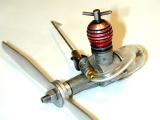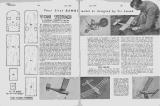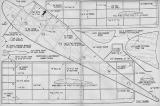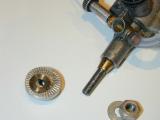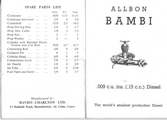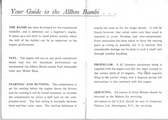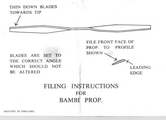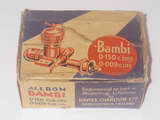| Name | Bambi | Designer | Hefin Davies (?) |
| Bore | 7/32" (5.55mm) | Stroke | 1/4" (6.35mm) |
| Type | Compression Ignition | Capacity | 0.15cc (0.009 cuin) |
| Production run | unknown | Country of Origin | England |
| Photo by | Ron C | Year of manufacture | 1954-1959 |
Background
Although there have been smaller capacity engines produced in small numbers, I'll climb out on a thin limb and declare that the Davies-Charlton Bambi is the smallest mass produced model engine ever made (until someone proves me wrong, again...) At 0.15cc, it is smaller in capacity than the famous Cox 010, although as a "diesel" is is larger and heavier. My research into the engine led first to the Aeromodeller engine review published in July 1954. From here, working back, a sequence of what today we'd call "teasers" show that the designers and staff at Aeromodeller know this would be a special engine, and so planned a special launch and introduction. Reading between the lines, it does not seem an unreasonable conjecture that deadlines and development problems led to frenzied activity behind the scenes. It all starts...
 ...in November 1953 when this full page placement appeared in the front advertising section of Aeromodeller, inviting readers to identify the engine's manufacturer and suggest a name. Note the quoted capacity at the time: "point one c.c.". The manufacturer should not have posed any significant challenge, given the strong family resemblance to the Davies Charlton (DC) 0.5cc Dart. The competition was necessarily run from Aeromodeller's editorial office as inviting people to send their cards and letters to DC Ltd would have been a dead give-away!
...in November 1953 when this full page placement appeared in the front advertising section of Aeromodeller, inviting readers to identify the engine's manufacturer and suggest a name. Note the quoted capacity at the time: "point one c.c.". The manufacturer should not have posed any significant challenge, given the strong family resemblance to the Davies Charlton (DC) 0.5cc Dart. The competition was necessarily run from Aeromodeller's editorial office as inviting people to send their cards and letters to DC Ltd would have been a dead give-away!
 The follow-up in the December 1953 issue, which carried a beautiful C. Rupert Moore painting depicting a pair of Fairey Swordfish "String-Bags" on the cover, would leave today's marketing graduates weeping. Splurge on a full-page add to kick-off the promo, generate 3000 responses from all over the planet, and follow-up with a postage stamp notice in small print under the red-spot on the page. But given the small, closed market and innocence of the times, it probably does not matter that much. Besides, the competition had been conducted under the auspices of the Aeromodeller itself, not DC ltd, so it was really Aeromodeller's responsibility to present the announcement and maintain the air of impartiality.
The follow-up in the December 1953 issue, which carried a beautiful C. Rupert Moore painting depicting a pair of Fairey Swordfish "String-Bags" on the cover, would leave today's marketing graduates weeping. Splurge on a full-page add to kick-off the promo, generate 3000 responses from all over the planet, and follow-up with a postage stamp notice in small print under the red-spot on the page. But given the small, closed market and innocence of the times, it probably does not matter that much. Besides, the competition had been conducted under the auspices of the Aeromodeller itself, not DC ltd, so it was really Aeromodeller's responsibility to present the announcement and maintain the air of impartiality.
 Websites are wonderful. I can revise my mistakes at any time, as I am doing now, more than a year after first posting this page. The Grand Announcement of the Name the Engine competition appeared in the January 1956 issue, in roughly the same page location of the magazine. In my original research, I missed this because I was expecting the announcement to come from DC. Wrong; and now I correct my earlier mis-information. So we have a full size placement by the Aeromodeller itself, far more "busy" than the last, and accompanied by a Ray Malmstrom cartoon (Ray was resident cartoonist and designer of wacky little models). Here we find the name selected, with the Walt Disney connection (no (tm) attribution—try that today), and learn that the "response was overwhelming", but the winner's name has been lost!
Websites are wonderful. I can revise my mistakes at any time, as I am doing now, more than a year after first posting this page. The Grand Announcement of the Name the Engine competition appeared in the January 1956 issue, in roughly the same page location of the magazine. In my original research, I missed this because I was expecting the announcement to come from DC. Wrong; and now I correct my earlier mis-information. So we have a full size placement by the Aeromodeller itself, far more "busy" than the last, and accompanied by a Ray Malmstrom cartoon (Ray was resident cartoonist and designer of wacky little models). Here we find the name selected, with the Walt Disney connection (no (tm) attribution—try that today), and learn that the "response was overwhelming", but the winner's name has been lost!
By the way, don't let the page numbers fool you. Aeromodeller's "volumes" ran January to December and pages were numbered sequentially, per volume. So the winner announcement appears on page 5, while the competition kick-off was on page 645 (of the previous volume). Both however were in the front advertising section that preceded the index and editorial page of the issues.
 In the same issue, the Trade Nodes column carries the official press release for the Bambi. Again we are told that the winner for the competition—an un-named Norwegian—had been selected by DC, and that the engine shall henceforth be known as the Allbon Bambi. Oops! While the case of the Spitfire says Allbon, the embossing on the Bambi clearly says DC Ltd—either this was a tribute by DC to the designer, or a mistake Aeromodeller was to repeat later when they reviewed the engine. Aeromodeller offered another dribble of pre-production information suggesting a late February release. The engine pictured is still one of the prototypes with the pocket-watch style crown-wheel compression screw, and the un-knurled prop driver with a 3/16" central boss.
In the same issue, the Trade Nodes column carries the official press release for the Bambi. Again we are told that the winner for the competition—an un-named Norwegian—had been selected by DC, and that the engine shall henceforth be known as the Allbon Bambi. Oops! While the case of the Spitfire says Allbon, the embossing on the Bambi clearly says DC Ltd—either this was a tribute by DC to the designer, or a mistake Aeromodeller was to repeat later when they reviewed the engine. Aeromodeller offered another dribble of pre-production information suggesting a late February release. The engine pictured is still one of the prototypes with the pocket-watch style crown-wheel compression screw, and the un-knurled prop driver with a 3/16" central boss.
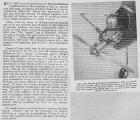 All went very quiet for the next three months and it's not until May 1954 that the engine gets another mention, once again in Trade Nodes. If we read between the lines here, we can guess that the gestation has been a troubled one with some frenzied testing and development being carried out at DC and by Aeromodeller staffer, Ron Moulton with the prototype providing "...brief flights served as reward for a very stiff right arm." In other words, the Bambi could not sustain so much as a powered glide!
All went very quiet for the next three months and it's not until May 1954 that the engine gets another mention, once again in Trade Nodes. If we read between the lines here, we can guess that the gestation has been a troubled one with some frenzied testing and development being carried out at DC and by Aeromodeller staffer, Ron Moulton with the prototype providing "...brief flights served as reward for a very stiff right arm." In other words, the Bambi could not sustain so much as a powered glide!
The text goes on to state that all this is now in the past and that the engine is "..the production Bambi, bored out to 0.13 c.c., with revised porting..." (underlining mine). In the accompanying photo, the engine now sports a conventional "V-T" style tommy-bar and the metal prop devised by the Aeromodeller staff ("tweak pitch for maximum climb"). It's hard to say from the black and white magazine picture, but it appears that the head may be plain aluminum—it certainly has eight fins, while production engines had six. Look closely and you'll also see a spacer behind the prop, and a tapered rear face on the prop driver, another aspect absent on production engines. All this suggests that this could be a another pre-production engine.
 Surprisingly, the debut of the Bambi in DC adds was a very restrained and low-key affaire. Perhaps the comparatively high cost of the engine was a factor—given that the January Aeromodeller Trade Notes entry had suggested the price "...might be slightly more than a Dart..." Although the price was reduced some years later, the initial retail price was stated as 108/11, including tax. That's five pounds, eight shillings and eleven pence in old money, or five pounds and 45 pence in decimal—say $10.90 at $2 to the pound—not a low priced engine. In contrast, the 0.5cc "Dart" (64/2) would have cost you about $6.21, while the largest engine in the range, the Manxman DC350 came in at just $6.43, reflecting the higher cost of maintaining tolerances as the engine capacity was reduced.
Surprisingly, the debut of the Bambi in DC adds was a very restrained and low-key affaire. Perhaps the comparatively high cost of the engine was a factor—given that the January Aeromodeller Trade Notes entry had suggested the price "...might be slightly more than a Dart..." Although the price was reduced some years later, the initial retail price was stated as 108/11, including tax. That's five pounds, eight shillings and eleven pence in old money, or five pounds and 45 pence in decimal—say $10.90 at $2 to the pound—not a low priced engine. In contrast, the 0.5cc "Dart" (64/2) would have cost you about $6.21, while the largest engine in the range, the Manxman DC350 came in at just $6.43, reflecting the higher cost of maintaining tolerances as the engine capacity was reduced.
The add clearly states the capacity as 0.15cc, confirming that the so-called production model that Aeromodeller had seen in May was still evolving. Note also the prominent "DC" cast into the crankcase on both sides. In a series of adds, DC drew careful distinction between DC and Allbon engines, with the Bambi clearly being one of the former. Today though, old modellers and collectors generally call it the "Allbon Bambi" and we'll see a possible explanation for this later.
In the same issue, Aeromodeller published a Vic Smeed design especially for the Bambi called the "Tom Thumb". The model was based on his hugely popular "Tomboy" design of 1950 and the size can be gauged from the fact that the full size plan fitted adequately across two pages of the magazine (Aeromodeller at the time was about 7" x 9").
The plan is interesting in that it shows the prop shape that the Aermodeller staff had finally settled upon as optimum for the engine: about 4" in diameter and 3/8" wide at the half-blade points. Made from 1/16" thick "dural" (or whatever piece of left-over Heinkel you could find lying around). The pitch was twisted in to "adjust for best climb". It was later noted in the Aermodeller Annual for 1954/55, that adjusting for about 10,000 rpm seemed to produce the best results. Although the calibrated resonant wire type of rpm guessing device was available commercially in the USA at this time, how your average UK modeller achieved this in the days before the ubiquitous digital, hand-held tachometer came into use is left to conjecture...
 Aeromodeller's Engine Review for August, 1954 is noteworthy for two reasons. First, the subject is the Bambi, headlined as the Allbon Bambi, even though all Davies-Charlton adds clearly identify it as a DC engine. Second, this review was to have been the first of a new series employing an eddy-current dynamometer. This device is a story unto itself, and replaced the equipment bequeathed to engine testers by our old friend Lawerence H Sparey when noise complaints in the North London area forced him out of the post of Chief-Engine-Tester. The problem was, with only one-half of one inch-ounce of torque, there was just no way the Bambi was going to spin the dyno rotor! The review (if you can read it from the patched together scans) gives Aeromodeller's recommended starting procedure, and notes the progression from 0.1cc to 0.15cc, stating with admirable British understatement that "...we would hesitate to recommend a Bambi for a relatively inexperienced modeller..".
Aeromodeller's Engine Review for August, 1954 is noteworthy for two reasons. First, the subject is the Bambi, headlined as the Allbon Bambi, even though all Davies-Charlton adds clearly identify it as a DC engine. Second, this review was to have been the first of a new series employing an eddy-current dynamometer. This device is a story unto itself, and replaced the equipment bequeathed to engine testers by our old friend Lawerence H Sparey when noise complaints in the North London area forced him out of the post of Chief-Engine-Tester. The problem was, with only one-half of one inch-ounce of torque, there was just no way the Bambi was going to spin the dyno rotor! The review (if you can read it from the patched together scans) gives Aeromodeller's recommended starting procedure, and notes the progression from 0.1cc to 0.15cc, stating with admirable British understatement that "...we would hesitate to recommend a Bambi for a relatively inexperienced modeller..".
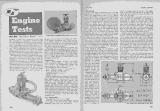 Rival English aeromodelling magazine, Model Aircraft beat the Aermodeller to press with their "official" review of the Bambi appearing in the June 1954 issue (the same month that the Tom Thumb appeared in Aermodeller). Their review also calls the engine the Allbon Bambi and notes the capacity progression from 0.1cc, to 0.136cc, finally to 0.154cc. They indulge in some overkill of decimal precision to give the bore as 0.2188 inch (7/32" to 4 places), with stroke at 0.250 inch. The weight is given as 5/8 oz. Again, the point is emphasised that both they (Model Aviation) and the Manufacturers agree the Bambi is not an engine for a beginner. The dimensioned three-views provided in their review clearly show a 3/16" boss in the middle of the prop drive washer—a feature apparently confined to early engines, and probably the only distinguishing indicator as DC engines carry no serial numbers.
Rival English aeromodelling magazine, Model Aircraft beat the Aermodeller to press with their "official" review of the Bambi appearing in the June 1954 issue (the same month that the Tom Thumb appeared in Aermodeller). Their review also calls the engine the Allbon Bambi and notes the capacity progression from 0.1cc, to 0.136cc, finally to 0.154cc. They indulge in some overkill of decimal precision to give the bore as 0.2188 inch (7/32" to 4 places), with stroke at 0.250 inch. The weight is given as 5/8 oz. Again, the point is emphasised that both they (Model Aviation) and the Manufacturers agree the Bambi is not an engine for a beginner. The dimensioned three-views provided in their review clearly show a 3/16" boss in the middle of the prop drive washer—a feature apparently confined to early engines, and probably the only distinguishing indicator as DC engines carry no serial numbers.
At least one scale plan (free flight) was published in Aeromodeller in subsequent years for the Bambi—a Luton Minor. DC adds continued appearing on the inside front cover page of every Aeromodeller issue (except December) into the 80's, but throughout its comparatively short production life, appearance of the Bambi in these adds was very irregular. Maybe the trickiness of handling such a small engine was resulting in relatively low sales figures, so DC targeted their marketing spend where the return was better. In April 1956, the price of the Bambi was reduced to 79/6 (say $7.95), bringing it more in line with the other engines in the sub-one cc range (the 0.75cc Merlin having been added in October 1954). This price was further reduced in February 1959 by a massive 2/- (that's 20c using our two dollars to the pound conversion factor).
 Only one kit appeared on the market for the Bambi. This was the KeilKraft Dandy, a free flight sport model boasting a massive 21" (53cm) wing span. The first advertisement for this kit appeared in KeilKraft's regular position on the rear cover of the Aeromodeller of April, 1955. It appeared again the next month, but as far as I can tell, this was the last time it was featured. Notice in the bottom right corner of the page that KeilKraft identify themselves as the sole UK Distributor for DC Engines. This provides a clue as to why they might go to the effort of kitting a design for an expert-level engine, requiring expert attention to weight during construction, followed by expert level balance and trimming.
Only one kit appeared on the market for the Bambi. This was the KeilKraft Dandy, a free flight sport model boasting a massive 21" (53cm) wing span. The first advertisement for this kit appeared in KeilKraft's regular position on the rear cover of the Aeromodeller of April, 1955. It appeared again the next month, but as far as I can tell, this was the last time it was featured. Notice in the bottom right corner of the page that KeilKraft identify themselves as the sole UK Distributor for DC Engines. This provides a clue as to why they might go to the effort of kitting a design for an expert-level engine, requiring expert attention to weight during construction, followed by expert level balance and trimming.
The instructions for the Bambi show how DC kept production costs down by making the filing of the aluminium prop blank a do it yourself job. Their assertion that starting procedure was ...exactly the same as for larger diesels." is open to some dispute, unless you consider the "team race start" procedure normal. It's worth mentioning that the price given for a replacement piston/cylinder assembly is the same as the complete price for a 0.75cc DC Merlin!
The demise of the Bambi production/promotion appears to have occurred in mid 1959. The last add I was able to locate for it in the British model press appeared in Aeromodeller of June 1959, although supplies to retailers probably held out longer. Coincidentally, this add announced yet another price reduction to 75/6, along with price adjustments to all the other DC engines in the range as well. 1959 was also the year Allan Allbon ceased his connection with Davies-Charlton Ltd, moving from the Isle of Mann back to his old stomping ground. There he formed a new partnership announcing the short-lived, but well made Allbon-Sanders AS55 0.55cc diesel. The Babbi box shown here may provide a clue as to why the engine was known as the "Allbon Bambi"—it's on the box top, even though the side DC as the maker.
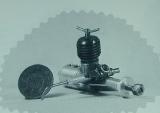 Davies-Charlton soldiered on for another twenty years—the last add I was able to find appearing in Aeromodeller of May 1983. There are two codas to the Bambi story. Folk-lore has it that DC planned to revive the Bambi in the early 1980's, going so far as to produce some prototypes such as the one pictured here, taken from Clanford's A-Z of Model Engines. Note the revised head shape, and aluminum fuel tank. The story goes that the project was shelved when DC was unable to find the original crankcase die! Russia supplies the last footnote for the Bambi with a reproduction that appeared briefly in the late 1990's. By all reports, this engine was if anything, superior to the originals in fits, finish, start-ability and performance. The asking price was over $100, but the collector market is now quite inured to figures like this, with original Bambis in reasonable condition fetching around US$250.
Davies-Charlton soldiered on for another twenty years—the last add I was able to find appearing in Aeromodeller of May 1983. There are two codas to the Bambi story. Folk-lore has it that DC planned to revive the Bambi in the early 1980's, going so far as to produce some prototypes such as the one pictured here, taken from Clanford's A-Z of Model Engines. Note the revised head shape, and aluminum fuel tank. The story goes that the project was shelved when DC was unable to find the original crankcase die! Russia supplies the last footnote for the Bambi with a reproduction that appeared briefly in the late 1990's. By all reports, this engine was if anything, superior to the originals in fits, finish, start-ability and performance. The asking price was over $100, but the collector market is now quite inured to figures like this, with original Bambis in reasonable condition fetching around US$250.
Running
Fortunately, my example is an easy starting engine, although the technique has to be mastered. Just follow the recommendation of Aeromodeller: set the prop at "10 to 4" and not so much flick it, as hit it! When cold, it seems to like being started rather "wet", with the compression backed off, advancing slowly to the desired running speed. After that, it will restart on the first flick (or clobber), with no change to the settings. The needle is un-critical and you do get the chance to open it again after going too far closed (some engines just stop abruptly at this point). All things considered, a nice little engine and certainly a must for collectors of British sport diesels.
![]()
